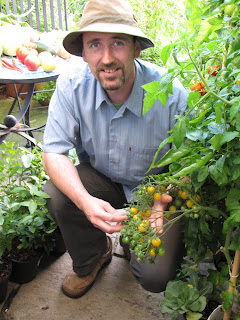Plot 34, the allotment, up high on the Dublin Hills at Bohernabreena hasn’t been seen by me since late October. There are potatoes, cabbages, celeriacs, more winter cauliflowers and other bits and bobs still in the ground. How would the worst snow since the 1980’s have affected them? For overseas readers, consider that (a) In Ireland, snow which stays longer than a night is an event that happens every five to ten years and (b) because of this, a lot of the crops we grow here are not used to it.
 |
| The White stuff - we're not used to it.. |
“I think the last time we’ve had ground temperatures so low was in 1970 when they reached minus eighteen degrees. Remember that the air temperature is always three or four higher than the ground.”
Alexander indicates a few other interesting points which food gardeners might not have been aware of.
“Those crops located in colder areas where the thaw happens more slowly are actually likely to experience the least damage whatever way ice crystals work with plants. The crops on southern facing areas which thaw quicker are far more likely to be damaged.”
 |
| Stephen Alexander from Teagasc |
“While most overwintering crops are hardy to frosts, many are not equipped for the extremes we’ve experienced lately when ground temperatures have fallen to minus twelve and remained below zero for sustained periods.”
So the following are Alexander’s views on the damage caused to other crops likely to be in the ground in gardens and allotments at the moment.
Potatoes
Thinking I was clever and eschewing the need to find storage at home for my King Edwards and Kerr Pinks, I simply left them in the ground which, given the weather, has turned out to be a bad idea. Alexander says: “Potatoes should not be in the ground at the moment. What you’re likely to find is that those nearest the surface have been damaged while those deeper may actually be alright. The problem is that potatoes can actually look on the outside when the damage is already done internally. Cut one open and take a look. If the flesh has a more watery consistency in some areas, they may be done for.”
Winter Cabbage
“Cabbage will fare differently depending on where it’s located and whether it got a protective covering of snow or not. Cabbage can be susceptible to the sorts of extreme temperatures we’ve been having. Sometimes, like potatoes, the rot can have occurred deep inside. Luckily for gardeners, unlike commericial growers you can just cut off the bad bits and use it anyway.”
Sprouts
“Like cabbage, it really depends on their local conditions even to the point of where they are located on your plot. Being a winter veg they’re normally fairly resilient. The same rules as cabbage apply.
 |
| The Roscoffs survived ok |
Cauliflower
“Essentially if your cauliflowers have been producing heads then you’re done for. The recent conditions will have turned them all to mush. However if they’re an overwintering variety that has yet to produce, and the plants are still in good condition, then you should be ok.” In my case, most of the Roscoffs I had in the back garden, and presumably therefore, those above in the allotment, seem to have emerged unscathed. Still not a white head in sight though.
Parsnips
“Absolutely bullet proof. I remember talking to a man who had gone through the notorious winter of 1947 and he told me that the parsnips were perfect afterwards.” Note: parsnips are one of those crops said to taste far better (nuttier apparently) after a dose of frost.
Garlic
“I’m surprised to learn that your (Plot 34’s) garlic sprouts have fallen down. Usually they’re pretty resilient and normally they’d be ok.” And true enough, once the snow melted, the tops of the garlic had wilted but within days new shoots were growing again.
Swedes
“Generally swedes should have weathered pretty well. Once you see them and they look ok then generally they are ok.” And again, our swedes have held up although some have a few rather large holes in them that I hadn't noticed before. So perhaps the odd one became a snow cabin for a pesky varmint or three.
Celeriac
“I’m not sure about celeriac because I’ve no experience of them in that type of weather. If they’re still growing and the roots are expanding then I guess they’re fine.” I'll have to wait to travel to the allotment to see how these guys are.
Carrots
“I’m sorry but if you had carrots in the ground then you’re completely bunched.” Many growers will have carrots in the ground as a means of storing them overwinter. In my case however, they never fired in the first place in one of the worst years ever for carrots on our allotment complex.
Apparently there's more snow forecast for February. Dang!

























.jpg)






